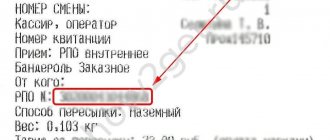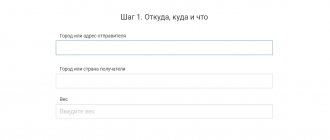Today, online shopping in online stores is becoming increasingly popular among residents of the Russian Federation, regardless of their age. However, as a rule, such purchases are delivered by Russian Post or some other courier service. If the buyer is not satisfied with the product or it arrived damaged, then he can freely refuse the parcel sent by cash on delivery by post. Despite the fact that the addressee has the right not to pick up a parcel from the post office, even one sent by cash on delivery, many are still interested in what may threaten the client of an online store and what consequences should be expected if the parcel is rejected.
Is it possible to change your mind and not pick up your purchase at Russian Post?
Payment methods for online purchases vary and not all of them are reliable. When paying in advance, it is easy to run into a scammer. A less risky option is cash on delivery, but there are pitfalls here too.
Cash on delivery means that the buyer pays the full cost of the goods only at the time of receipt of the parcel by mail.
The shopping algorithm consists of several simple steps:
- Selecting a product and placing an order on the seller’s website.
- Confirmation of an order.
- Formation and sending of an order by mail to the specified address.
- Notifying the client about the arrival of the goods by mail.
- Payment by the buyer for the parcel.
The contents of the mail may not always correspond in weight, value or size to what was ordered on the website. The packaging may be damaged, the seller sent low-quality products, or you changed your mind about taking the product. In such cases, you have the right to refuse the parcel legally.
You can find out whether you can cancel an online order and how to do it before and after receiving the parcel here.
Do I need to explain the reason for refusal?
According to current legislation, the addressee may refuse to receive a shipment with cash on delivery for virtually any reason and without explaining his reasons. However, if the recipient nevertheless decides to visit the post office and inform about his desire not to pick up the item, then he will need to indicate the reason for the refusal on the appropriate form. In this case, the client will be obliged to pay the postal service the cost of the return shipping service.
If the recipient decides not to pick up the parcel with cash on delivery due to its non-compliance with the description, then he can try to request a refund from the seller for the return shipment of the goods. If the seller ignores such requirements, then you can try to influence him by contacting Rospotrebnadzor or even the court. True, since the cost of delivery cannot be called high, initiating proceedings in court would be an irrational decision.
Grounds for refusing to receive mail
The grounds for returning goods are specified in the following regulatory documents:
- Federal Law “On the Protection of Consumer Rights” – clause 4 of Art. 26.1.
- Civil Code of the Russian Federation – clause 4 of Art. 497.
- Rules for the provision of postal services – clause 45.
The reasons for refusing the sent goods may be:
- Contents inconsistency: for example, the buyer ordered a large item, but the external size of the package is different.
- There is a difference between the actual price and the price in the online store.
- The customer is not able to redeem the parcel: he went to the hospital, left the city, etc.
- They sent a low-quality product (how to return a low-quality product to an online store?).
- The product did not meet some parameters.
They sent the wrong product
If you received a product that was not the one you ordered, you have the right to make a written claim to the seller demanding a refund of the money spent.
According to Art. 26.1 of the Federal Law “On the Protection of Consumer Rights”, the buyer has the right to refuse the goods within 7 days after receiving it. If the agreement between the seller and the consumer did not establish possible return periods, the consumer has the right to refuse the goods within 3 months from the date of transfer of the goods.
The procedure for returning a parcel to the online store is as follows:
- Notifying the seller about the return of products.
- Drawing up a return application.
- Sending the goods to the seller.
Shipping back in such cases is carried out at the expense of the online store, you do not pay anything.
You need to send the return parcel and application at the post office to the address of the online store. Many are also interested in how exactly to write an application and formalize the refusal: the return is carried out by parcel with a description of the contents and a receipt. The description is made in two copies, one of which remains with the buyer.
The seller is obliged to return the money for the goods no later than 10 days from the date of receipt of the claim. Refunds are made by postal order, in cash or by transfer to a card . You must provide your bank details for a refund.
A defect came from the online store
According to paragraph 1 of Art. 18 Federal Law “On the Protection of Consumer Rights”, if the buyer discovers that the product has a defect or a significant defect, he can demand from the store:
- free repairs or compensation for correction of defects by the consumer or other person;
- proportionate reduction in purchase price;
- replacement with the same product or a similar product of another brand with recalculation of the difference in price.
The condition is valid for 15 days from the date of transfer of such goods to the consumer.
The purchaser may exercise these rights under the condition that the seller did not notify about the unsuitable quality when ordering. The buyer also has the right to file a claim regarding other identified defects in the purchase.
Based on Art. 21 of the Federal Law “On the Protection of Consumer Rights”, the product must be replaced within 7 days from the date of presentation of the specified requirements by the buyer. If a product is out of stock, it will be replaced within a month from the date the buyer submits a claim.
All necessary checks must be carried out within 20 days from the date of the consumer complaint. If the product is found to be unsuitable due to the fault of the consumer, payment for the examination and all associated transportation costs is borne by the buyer.
The consumer has the right to insist on the presentation of a similar product to him for free temporary use if the repair is carried out longer than 3 days from the time the claim was filed. The defective product is replaced with a new, unused one.
If the purchaser finds problems with a technically complex product, he has the right to refuse the transaction , return his money or exchange the product for a product of the same brand, model and article. In this case, it is necessary to recalculate the market value.
The list of technically complex goods is indicated in Decree of the Government of the Russian Federation of November 10, 2014 No. 924.
The seller is obliged to return the money to the buyer within 10 days from the date of filing a written application.
Read more about how to return low-quality goods to an online store and how to justify your refusal here.
The product did not fit (provided that it is not in PP No. 55)
According to paragraph 4 of Art. 26.1. Federal Law “On the Protection of Consumer Rights”, if the package for one reason or another does not suit the purchaser, it can be returned at any time before delivery or after delivery 7 days. In the absence of written information about the procedure and conditions for returning products, the purchaser may refuse the purchase within up to 3 months from the day the package was received.
When making a return, the following additional conditions must be taken into account:
- presentation of the product, integrity of the packaging, availability of complete equipment;
- no chips, abrasions or signs of use;
- preservation of consumer properties of the product;
- availability of a receipt or document confirming payment.
In accordance with the Law “On ZPP”, in the absence of receipts or other documents confirming payment, the buyer has the right to refer to other evidence of purchase of products.
You must return an unsuitable product with a written complaint to the online store where the order was placed.
The seller is obliged to return the money back to the client within 10 days.
What to do when receiving an order with cash on delivery.
Many online store clients prefer to make cash on delivery payments. It is stipulated that the customer transfers a sum of money to the seller after receiving the parcel.
It includes payment for goods not only for shipping, but also for transport services, storage of goods, and translation.
Refusal of parcels by cash on delivery is regulated by Art. 26 of Law No. 2300-1 “On the Protection of Consumer Rights”. It states that the buyer can cancel his order at any time before receiving it and paying for it.
But purchasing goods remotely implies concluding a purchase and sale agreement.
In accordance with Art. 497 of the Civil Code of the Russian Federation, its termination is possible only if the seller is reimbursed for transportation costs.
The main risks when selling cash on delivery are borne by the seller. If the buyer does not show up at the post office to pick up the parcel in a timely manner, its storage and return transportation is paid for by the sender.
The seller can file a claim in court to withhold this amount from the recipient.
Thus, the refusal of the parcel at the post office is formalized before payment and receipt.
This is done in the following ways:
- By visiting the post office and writing a statement of refusal to receive the parcel.
- Failure to show up at the post office on time.
After receiving the notification, the citizen is obliged to pick up the parcel within 30 days. If this does not happen, then it is returned to the address to which it was sent. Postage costs in this case are charged to the sender.
In the latter case, the seller can recover compensation through the court.
Reasons for parcel refusal.
The buyer may refuse to purchase the parcel for the following reasons:
- discrepancy between the amount to be paid and that indicated by the seller when concluding the purchase and sale agreement;
- change in the packaging weight characteristics from those originally stated;
- discrepancy between product sizes, etc.
In such cases, the court will side with the consumer.
How to check before payment and whether the package is allowed to be opened?
Cash on delivery is popular among buyers because they assume they can open the package first and see the item before paying. However, opening the package is permitted only after payment has been made.
You can refuse a parcel without opening it, based only on external signs: a different order amount or questionable contents.
At the post office, you can check the integrity of the packaging and compliance of the weight with the specified data in the online store. If there are no comments on external parameters, claims can be made after payment , since cash on delivery only ensures the fact of arrival of the shipment, but does not guarantee its contents.
Useful tips
It would be correct to refuse to receive an order with cash on delivery by drawing up a special act in the mail indicating the reason for the refusal. In this case, it is recommended to take a copy of the act, which the addressee may need if the seller tries to go to court with a demand for payment of financial compensation for the time and money spent on sending the goods. The act will act as documentary evidence of the fact that the parcel is damaged or does not correspond to the description on the seller’s website.
Refusal methods: how to return a purchase to the sender?
There are two ways to cancel an order by mail and send it back.
Correct
The buyer comes to the post office and draws up a written refusal to purchase the parcel. A special note about the action should be made in the postal notice.
Wrong
Do not redeem the postal item and find out a month later that the received parcel was sent back to the seller. In this method, the consumer does not incur any monetary expenses.
The first method is the most preferable for the buyer. Taking into account paragraph 44 of the Rules established by the Government on July 31, 2014 N 234, the refusal of postal items is carried out by the buyer by putting a corresponding mark in the notice.
What happens if you refuse a regular parcel?
A regular parcel is subject to the same rules as the cash on delivery option, so refusing it leads to the same consequences. There is no difference other than shipping costs will be lower. But if a regular parcel arrives with the goods, this means that the client has made an advance payment and, if refused, may well lose the transferred money. This is unacceptable, therefore, if it is impossible to receive the parcel, you must first contact the seller.
Having explained to him the situation and the fact that the goods were not received, you can ask for a full refund, minus the costs that the party incurred for the initial shipment of the goods. Usually there are no problems with this, but if there is a categorical refusal to make a return in this way, the client can file a complaint with Rospotrebnadzor, then the seller will face inspections and fines.
Why don't buyers pick up goods that came from the online store?
The buyer has the right to familiarize himself with the quality of the goods before paying for it. Parcels sent by cash on delivery can be opened before receiving them. However, this only applies to cases where there is an inventory of the goods inside. If it is missing, then postal employees may deny the buyer the right to familiarize themselves with the contents of the package or box.
This technique is often used by scammers. A conscientious seller will definitely include an inventory in the shipment. This document must list the goods contained in the parcel.
Concept: features and risks
Cash on delivery is a remote method of purchasing goods (via the Internet), in which the buyer pays for it only after receiving it at the post office/delivery by courier. In this situation, the main risks fall on the shoulders of the seller, since by sending the goods he is actually left without paying for it. The disadvantages of selling goods in this way for the seller include:
- The need to visit the post office twice : first the seller needs to send the goods, and later, when the buyer receives and pays for it, receive money for it at the post office;
- Delay in receipt of profit. By sending goods by cash on delivery, the seller is deprived of the opportunity to earn money simultaneously with the sale of goods, which is why the turnover of funds slows down;
- The risk of refusing to purchase a product. After examining the product, the buyer may change his mind about buying it. In this case, the seller will be forced to pay for double delivery and storage of the goods at the post office;
If the buyer himself wants to return the money for the goods received and paid for by cash on delivery, this will result in double expenses for him:
- He will have to pay for the goods to be sent to him and back to the seller;
- The buyer will also have to pay for the refund from the seller;
It will be extremely difficult to return the parcel, and especially the money for it, since during its delivery the seller’s financial situation may seriously change.
Read about how to properly refuse a parcel and money received by cash on delivery in the next section.









